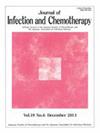Disproportionality analysis of amenamevir-induced encephalopathy using the Japanese adverse drug event report database
IF 1.9
4区 医学
Q3 INFECTIOUS DISEASES
引用次数: 0
Abstract
Introduction
Anti-herpesvirus drug-induced encephalopathy can complicate herpes zoster treatment; however, the association between the recently developed anti-herpesvirus drug amenamevir and encephalopathy development remains unknown. Determining the characteristics of amenamevir-induced encephalopathy is essential for potentially improving patient outcomes in the treatment of herpes zoster. The aim of this study is to identify the association between amenamevir treatment and encephalopathy and to determine the risk factors for amenamevir-induced encephalopathy via disproportionality analysis using the Japanese Adverse Drug Event Report (JADER) database.
Method
We conducted a retrospective observational study using anonymized data from the JADER database. Encephalopathy was defined according to the Standardized Medical Dictionary for Regulatory Activities Queries specific to “Noninfectious encephalopathy/delirium.” Disproportionality analysis was used to calculate the reporting odds ratios (RORs) and 95 % confidence intervals (CIs) to assess associations between amenamevir and encephalopathy. Multivariable logistic regression considered age, gender, chronic kidney disease, and cytochrome P450 3A inhibitor use as potential risk factors.
Results
Out of 713,316 patients, 246 were prescribed amenamevir. The median onset of encephalopathy in these patients was 3 days. Disproportionality of encephalopathy was observed in patients treated with amenamevir (ROR, 3.44; 95 % CI, 2.48–4.78). Furthermore, multivariable logistic regression analysis suggested that an age of ≥70 years was associated with amenamevir-induced encephalopathy (ROR, 7.63; 95 % CI, 2.25–25.9).
Conclusion
These results suggest that amenamevir treatment may be associated with encephalopathy, particularly in patients aged ≥70 years. Healthcare providers should be aware of this potential risk, especially in elderly patients, to prevent severe central nervous system complications.
利用日本药物不良事件报告数据库对阿米那韦引起的脑病进行比例分析。
简介:抗疱疹病毒药物诱发的脑病可能会使带状疱疹的治疗复杂化;然而,最近开发的抗疱疹病毒药物阿美那韦与脑病发生之间的关系仍然未知。确定阿美那韦诱发脑病的特征对于改善带状疱疹患者的治疗效果至关重要。本研究旨在利用日本药物不良事件报告(JADER)数据库,通过比例失调分析确定阿美那韦治疗与脑病之间的关联,并确定阿美那韦诱发脑病的风险因素:我们利用 JADER 数据库中的匿名数据开展了一项回顾性观察研究。脑病是根据《监管活动查询标准化医学字典》中专门针对 "非感染性脑病/谵妄 "的定义。采用比例失调分析法计算报告几率比(ROR)和95%置信区间(CI),以评估阿米那韦与脑病之间的关系。多变量逻辑回归考虑了年龄、性别、慢性肾病和细胞色素P450 3A抑制剂的使用等潜在风险因素:在713,316名患者中,有246人被处方阿米那韦。这些患者出现脑病的中位时间为 3 天。在接受阿美那韦治疗的患者中观察到脑病的比例失调(ROR,3.44;95 % CI,2.48-4.78)。此外,多变量逻辑回归分析表明,年龄≥70岁与阿美那韦引起的脑病有关(ROR,7.63;95 % CI,2.25-25.9):这些结果表明,阿美那韦治疗可能与脑病有关,尤其是年龄≥70岁的患者。医疗服务提供者应意识到这一潜在风险,尤其是老年患者,以防止出现严重的中枢神经系统并发症。
本文章由计算机程序翻译,如有差异,请以英文原文为准。
求助全文
约1分钟内获得全文
求助全文
来源期刊

Journal of Infection and Chemotherapy
INFECTIOUS DISEASES-PHARMACOLOGY & PHARMACY
CiteScore
4.10
自引率
4.50%
发文量
303
审稿时长
47 days
期刊介绍:
The Journal of Infection and Chemotherapy (JIC) — official journal of the Japanese Society of Chemotherapy and The Japanese Association for Infectious Diseases — welcomes original papers, laboratory or clinical, as well as case reports, notes, committee reports, surveillance and guidelines from all parts of the world on all aspects of chemotherapy, covering the pathogenesis, diagnosis, treatment, and control of infection, including treatment with anticancer drugs. Experimental studies on animal models and pharmacokinetics, and reports on epidemiology and clinical trials are particularly welcome.
 求助内容:
求助内容: 应助结果提醒方式:
应助结果提醒方式:


